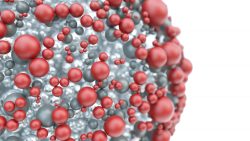 Nano-particles can be useful and even valuable in a variety of products, however according to a recent study they can also damage our cells. Researchers are now concerned about the effects of lifelong exposures to this human organism.
Nano-particles can be useful and even valuable in a variety of products, however according to a recent study they can also damage our cells. Researchers are now concerned about the effects of lifelong exposures to this human organism.
Nano-particles are used in a wide variety of manufacturing processes and products. This is due to the fact that the properties of a material can dramatically change when that material comes down in nano form.
These particles are used to transport medicine around the body and to purify wastewater. They are also added to pillows, socks, phone covers, mattresses and refrigerators which supplies these items with an antibacterial surface.
A large amount of research has been conducted on how nano-particles affect the environment and humans. Some studies have shown that nano-particles can damage or disrupt human cells. This has been recently confirmed by the new study that also studied how cells react when they have been exposed to more than one type of nano-particle at the same time.
We are exposed to many different kinds of nano-particles throughout our lifetime. The research team involved with the new study set out to investigate how the combination of different nano-particles can affect us and in addition whether an accumulation throughout a life can harm us.
In the new study, the team looked at nano-platinum and nano-silver. They not only looked at the individual effect but also whether exposure to both types result in a synergy effect in two types of cells in the brain.
Nano-silver was chosen because it is already known to be able to damage cells and nano-platinum because it is considered to be a bio-inert which means it has a minimal interaction with human tissue.
Both nano-particles were tested on two types of cells found in the brain – astrocytes and endothelial cells. Astrocytes are supporter cells found in the central nervous system which helps in supplying the nervous system with nutrients and repair brain damage. Endothelial cells reside on the inside of the blood vessels and transport substances from the bloodstream to the brain.
When the team exposed endothelial cells to nano-platinum nothing happened. When they were exposed to nano-silver their ability to divide resulted in deterioration. When the cells were exposed to both nano-platinum and nano-silver, the resulting effect amplified and large numbers of the cells died. Additionally, their defense mechanisms decreased and they also had difficulty communicating with each other.
Even though nano-platinum by itself did no harm, something drastic happened when they were combined with a different kind of nano-particle. The astrocytes were hardy and only reacted with impaired ability to divide when they were exposed to both nano-platinum and nano-silver.
An earlier study has shown a dramatic synergy effect of nano-silver and cadmium ions which are naturally found all around us on earth. This study showed that 72% of cells in the intestine died when they were exposed to both nano-silver and cadmium ions. When these cells were exposed to just
nano-silver 25% died. When exposed to cadmium ions alone, 12% died.
Unfortunately, little is known about how large concentrations of nano-particles are used in industrial products. It is also not known what size particles are used. Size has also shown an effect on whether they can enter a cell. What we do know is that many people are involuntarily exposed to nano-particles and there can easily be lifelong exposure.
Currently there are no restrictions on adding nano-particles to products. However, in the EU manufacturers must have approval if they want to use nano-particles in products that have antibacterial properties and in Denmark, they must also declare nano-contact on product labels containing them.
To view the original scientific study click below
The Cytotoxicity of Metal Nanoparticles Depends on Their Synergistic Interactions





